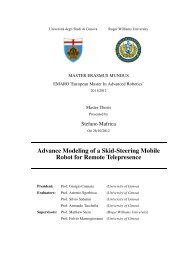East Bay Coalition for the Homeless - Roger Williams University
East Bay Coalition for the Homeless - Roger Williams University
East Bay Coalition for the Homeless - Roger Williams University
You also want an ePaper? Increase the reach of your titles
YUMPU automatically turns print PDFs into web optimized ePapers that Google loves.
At this stage, <strong>the</strong> organization does not know where to start. It collects data from time-to-time, but doesn’t do <strong>for</strong>mal<br />
reporting. What data is collected doesn’t relate to decision-making. There are no systems in place, no dashboards, and<br />
no collection methods. Staff is often overwhelmed by <strong>the</strong> thought of measurement and <strong>the</strong> task falls to <strong>the</strong> bottom of<br />
<strong>the</strong> to-do list. There is no process <strong>for</strong> analyzingsuccess or failure. Decisions are all passion-driven.<br />
These nonprofits need to develop a basic communications strategy or program plan. They will learn and benefit from<br />
inspiring stories from peers. Perhaps your organization already has a robust program plan or communications strategy<br />
in place, but is facing challenges to adopting a networked way of working. If so, you should start with a discussion of<br />
<strong>the</strong> issues, followed by codifying <strong>the</strong> rules in a social media policy.<br />
Walk<br />
The nonprofit as <strong>the</strong> “Walk” stage is using one or more social media tools consistently, but this use may or may not<br />
be linked to a communications strategy, campaign, or program plan. Or, <strong>the</strong>y may be approaching social media as a<br />
groadcast channel and not engaging or only sharing content and messaging from <strong>the</strong>ir own organization.<br />
They have in place best oractices on tools and techniques as part of <strong>the</strong> organizational skill set, but may need assistance<br />
developing a social media strategy to support short and long-term SMART (Specific, Measurable, Achievable, Ralistic,<br />
and Time) objectives.They may also need help to correctly identify <strong>the</strong> audiences <strong>the</strong>y need to target.<br />
Walkers have internalized listening and are able to use <strong>the</strong> data <strong>the</strong>y collect to improve engagement and content best<br />
prctices. At this stage, leadership may not fully understand social media and networked ways of working. Often, <strong>the</strong><br />
question “What’s <strong>the</strong> value” surfaces. The organization should implement a small, low-risk pilot that can collect<br />
stories and numbers to help leadership better understand <strong>the</strong> value and benefit of costs. The nonprofit in <strong>the</strong> “Walk”<br />
stage needs to avoid spreading <strong>the</strong> organization’s resources too thin. It should focus on one or two social media tools,<br />
going deep on tactics, and generating tangible results to demonstrate value.<br />
“Walkers” must identify low-cost ways to build capacity internally, like using interns or volunteers effectively and integrating<br />
social media tasks into existing job descriptions. Staff members should evaluate current job tasks and identify<br />
what <strong>the</strong>y don’t need to do in order to make time <strong>for</strong> social media and o<strong>the</strong>r emerging technologies, all with support<br />
from leadership. They must also enlist <strong>the</strong> help of <strong>the</strong>ir social networks outside <strong>the</strong>ir organization.<br />
A “walking” momprofit’s social media policy <strong>for</strong>malizes <strong>the</strong> value and vision <strong>for</strong> social media use and networked approach<br />
and encourages free agent outsiders to help with implementation. The organization integrates simple measurement<br />
techniques and learning as an organizational habit that helps improve practice. The organization has begun to<br />
set up a process <strong>for</strong> experimenting, learning, and adotpting new channels in full, if appropriate.<br />
At this stage, <strong>the</strong> organization is regularly collecting data but not in a consistent manner. For example, different<br />
people and departments may be collecting data but not sharing it. Or data is focussed on <strong>the</strong> metrics that are specific<br />
to social media channels but not linked to high-level organizational results or mission-driven goals across programs<br />
and could, in fact, be <strong>the</strong> wrong data. Disscussions on how to improve results are rarely part of staff meeting, nor are<br />
<strong>the</strong>re linkages to organizational experience. The organization does not understand <strong>the</strong> fine distinction between being<br />
data-driven and <strong>the</strong> intelligent use of data.<br />
118
















